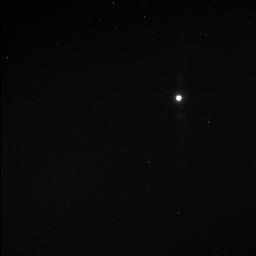
|
A View of Venus while Searching for Vulcanoids
- Click the image above for a larger view
- Full-Res JPEG (1024 x 1024) (52.4 kB)
- Full-Res TIFF (1024 x 1024) (1.1 MB)
Caption:
Images from the latest vulcanoid search are currently being transmitted to Earth, and one of those 256 images is shown here. Vulcanoids are small rocky bodies that have been postulated to exist in orbits between Mercury and the Sun, though no such object has yet been detected. MESSENGER has the unique opportunity to search for smaller and fainter vulcanoids than has ever before been possible. The best opportunities for MESSENGER to search for vulcanoids are during perihelion passages, when the spacecraft's orbit brings it closest to the Sun. MESSENGER has searched for vulcanoids during three perihelion passages to date, in June 2008 , in February 2009 , and most recently in January 2010. There will be another three perihelion passages in 2010, which will provide additional opportunities to continue the search. MESSENGER images acquired to date have not revealed any vulcanoids. The bright object in the image here is Venus. For examining Venus, the image is over-exposed, but in the quest for very small, very faint objects, this type of image is just what is needed.
Date Acquired:
January 16, 2010
Image Mission Elapsed Time (MET):
172094712
Instrument:
Wide Angle Camera (WAC) of the Mercury Dual Imaging System (MDIS)
WAC Filter:
2 (clear filter)
Field of View:
The WAC has a 10.5° field of view
Background Info:
These images are from MESSENGER, a NASA Discovery mission to conduct the first orbital study of the innermost planet, Mercury. For information regarding the use of images, see the MESSENGER image use policy .
Cataloging Keywords:
| Name | Value | Additional Values |
|---|---|---|
| Target | Venus | Mercury |
| System | ||
| Target Type | Planet | |
| Mission | MESSENGER | |
| Instrument Host | MESSENGER | |
| Host Type | Orbiter | |
| Instrument | Mercury Dual Imaging System (MDIS) | |
| Detector | Wide Angle Camera (WAC) | |
| Extra Keywords | Grayscale | |
| Acquisition Date | ||
| Release Date | 2010-02-02 | |
| Date in Caption | 2010-01-16 | |
| Image Credit | NASA/Johns Hopkins University Applied Physics Laboratory/Carnegie Institution of Washington | |
| Source | photojournal.jpl.nasa.gov/catalog/PIA12443 | |
| Identifier | PIA12443 | |
